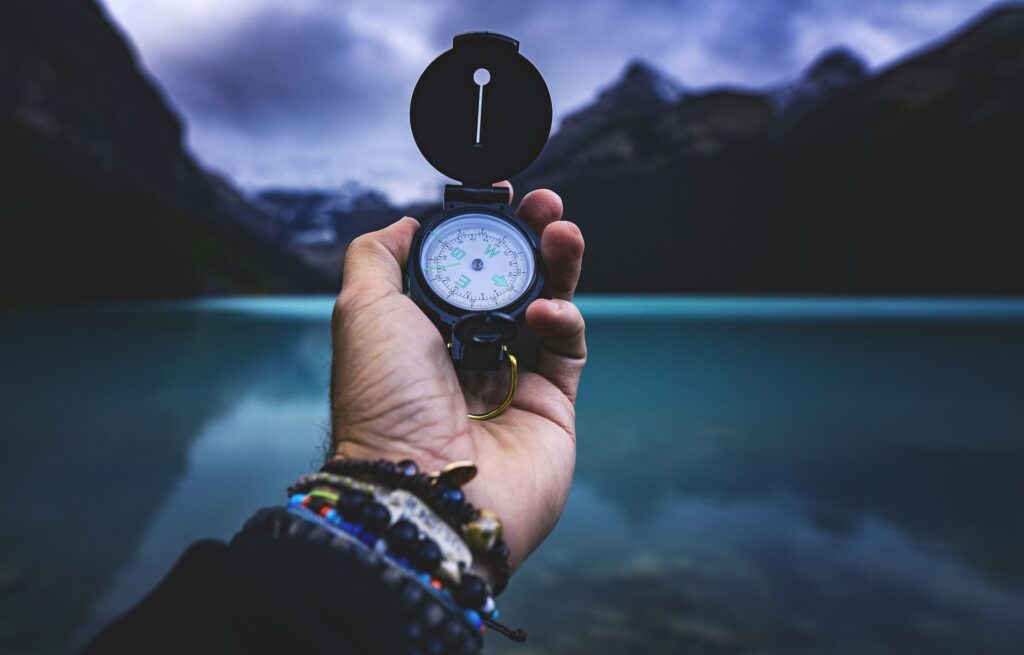In today’s high-tech world, where GPS-enabled smartphones seem to dominate navigation, there’s still an essential tool that every outdoor enthusiast should have in their kit – the trusty compass. While technology can be a fantastic aid, it’s important not to underestimate the value of learning how to navigate with a compass, especially when you’re out in the wilds of the UK. In this article, we’ll explore why compass navigation remains an indispensable skill for campers and hikers and provide a beginner’s guide to get you started.

Why Learn Compass Navigation?
Reliability: Unlike electronic devices, compasses don’t rely on batteries or a signal. They work in all weather conditions and won’t leave you stranded due to a dead battery.
Simple and Lightweight: Compasses are small, lightweight, and easy to carry. You can slip one into your pocket or backpack without adding significant weight.
Back-Up for GPS: While GPS devices are handy, they can malfunction or lose signal in challenging terrains, such as dense forests or deep valleys. A compass can be a lifesaver in such situations.
Getting Started with Compass Navigation
Select the Right Compass:
- Invest in a good-quality baseplate compass with a clear, easy-to-read dial and a transparent baseplate for map reading.
- Ensure your compass has a built-in declination adjustment, a valuable feature for precise navigation.
Understanding Compass Basics:
- The needle: The red end of the needle always points to magnetic north.
- The orienting arrow: Used to set your compass to match your map’s orientation.
- The direction of travel arrow: Points in the direction you want to go.
Orienting Your Map:
- Lay your map flat on a surface.
- Place your compass on the map so that the edge of the baseplate runs from your starting point to your destination.
- Rotate the compass housing until the magnetic needle aligns with the orienting arrow.
Taking a Bearing:
- Find a prominent landmark in the distance.
- Rotate the compass housing until the direction of travel arrow aligns with the landmark.
- Read the degree marking on the compass’s dial. This is your bearing.
Following a Bearing:
- Hold the compass in front of you with the direction of travel arrow pointing away.
- Rotate your body until the red end of the needle lines up with the orienting arrow.
- The direction of travel arrow now points you in the right direction.
Checking Your Progress:
- As you walk, periodically check your compass to ensure you’re still following your bearing.
- Landmarks, terrain features, and map reading should also corroborate your direction.
Adjust for Declination:
- Consult your map for the local magnetic declination, which is the angle between true north (the North Pole) and magnetic north.
- Use your compass’s declination adjustment to correct for this difference.

While modern technology undoubtedly enhances outdoor adventures, the art of compass navigation remains an essential skill for every camper and hiker. It’s a reliable, lightweight, and simple tool that can literally help you find your way when all else fails. By learning how to use a compass and practicing your skills in the great outdoors, you’ll not only enhance your self-reliance but also deepen your connection with the beautiful landscapes of the UK. So, don’t forget to add a compass to your kit and start honing your navigation skills – you’ll be glad you did on your next camping or hiking trip.
Andy Halliday is a passionate outdoor enthusiast and an avid camper. He has been exploring the wilderness and camping in the great outdoors for over two decades, and his experiences have inspired him to write about the joys of camping and the beauty of nature.
As a camping enthusiast, he believes that spending time in the wilderness is not just a way to escape the daily grind, but also a way to connect with nature and gain a deeper appreciation for the natural world. Andy has camped in various locations across the country and on two different continents. He has a wealth of knowledge and experience to share with fellow campers.
Through his writing, he hopes to inspire you to venture out into the wilderness and experience the beauty and serenity of camping. Andy articles and guides provide useful tips, advice, and insights on everything from selecting the right gear and equipment to finding the best campsites and hiking trails.





